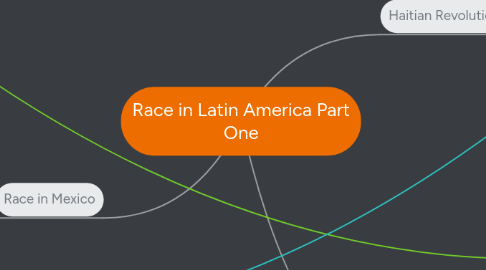
1. Race in Mexico
1.1. People in Mexico in the early 20th century were grouped into racial classes; whites were the dominant class
1.1.1. The modern Mexican population is a mix of several ethnic groups; Spanish and Indian miscegenation is a perfect example of the blurring of the lines of race
1.1.1.1. generations of miscegenation had thoroughly blurred the lines of the "racial" divisions of the early colony.
1.2. The Mexican Dictator Profirio Diaz's ethnic roots were Indian, but was considered to be "white"
1.2.1. Example of how "upwardly mobile" individuals were "whitened" by the Mexican population
1.2.1.1. It took more than physical appearance to determine if an individual was "Indian" or "white"
1.3. Defining the racial category of "Indian" is a tough process that many observers of the people and landscape have trouble settling on
1.3.1. Offical (census-taking) observers prefer a more narrow definition of "Indian", while unoffical, indigenista spokesperson prefer a broader thus more numerous definition of "Indian"
1.3.1.1. Example of how the process of "mestizaje" is not racial as many believe, but rather social
1.4. People in Mexico determined if a person was "Indian" in a variety of ways; "Indians" were seen as being darker, but the identification process went beyond the somatic
1.4.1. Language, dress, religion, social organization, culture and consciousness played a huge role in determining the ethnic identification of an individual
1.4.1.1. These were social attributes, and not all boiological; this meant they could be subject to change
1.4.1.1.1. Indians could become Mestizos through the smallest of educational, migration and occupational shifts
1.5. The perception of a community in Mexico could be subject to various interpretations
1.5.1. Commentators such as Alfonso Caso noted that a community is Indian if they consider themselves to be Indian
1.5.1.1. A community's social and cultural make up did not come into play; At an individual level, if a person identified as being a part of an indigenous community then they were "Indian"
1.5.1.1.1. Due to this information, Indians are socially defined rather than racially; race is used as a genetically unsound shorthand for ethnicity
2. Haitian Revolution
2.1. First instance in history when slaves had won their freedom
2.1.1. After the slaves defeated the french troops deployed there, Napoleon sent more 12,000 more troops to combat them
2.1.1.1. The French Coloreds and Slaves were successful at defeating the second round of troops deployed; after they had officially established the nation of Haiti in 1804, the black leader Jean-Jaques Dessalines ordered the massacre of whites remaining on the island
2.2. The french had control of the island nation now known as Haiti; the black slaves grew tired of being treated horribly and they revolted
2.2.1. The United States secretly participated in the Haitian Revolution; President John Adams sent ships to supply the slaves and coloreds with supplies and weaponry
2.3. There were actually groups of black people in Haiti that weren't slaves; These people were free blacks and coloreds, and generally supported the slave regime
2.3.1. Many people of color in the North Province had become managers of sugar estates; would go after and capture slaves that had run away
2.3.1.1. French coloreds resented the indignities and discriminations designed to reduce them to an undercaste
2.3.1.1.1. The mistreatment of both the French coloreds and the black slaves led to the revolt that cost the French their territory and established Haiti as a new nation
3. Fight For Racial Equality
3.1. On January 2 1893 Frederick Douglas delivered a speech dedicating the Haitian Pavilion at the Chicago World's Fair; commemorated the events of the Haitian revolution
3.1.1. Douglas credited the freedom of blacks around the worlds to the Haitians' act of rebellion; "When they struck for freedom... they struck for the freedom of every black man in the world"
3.2. Many Whites in the U.S. were outraged when they learned of the Haitian Revolution
3.2.1. Many feared that the emancipation of slaves in the U.S. would lead to a massacre of whites
3.2.1.1. The ordering of the massacre of remaining whites on Haiti by Dessalines served to isolate the island Nation; was not a good start for a nation inhabited by former slaves that needed a good image in the eyes of the European nations
3.3. A black orator in 1825 said that Haiti presented "an irrefutable argument to prove... that the descendants of Africa were never designed by their creator to sustain an inferiority, or even a mediocrity, in the chain of being; but they are as capable of intellectual improvement as Europeans, or any other nation upon the face of the earth."
3.3.1. Many Blacks in the U.S. saw the slaves' triumph in Haiti as a triumph for all back people across the world; it served as proof that they were not meant to be socially and intellectually inferior to whites'
